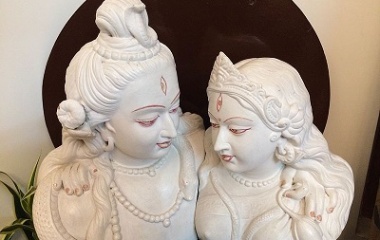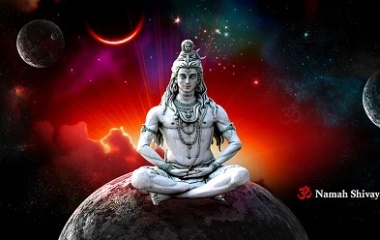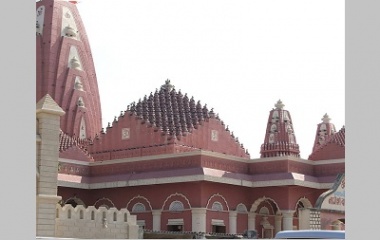- Pronunciation: SHEE-vah
- Origin: Hindu
- Role: God of Creation, Destruction and Arts
- Symbols: Third Eye, Trident
- Children: Kartikeya, Ganesha
- Other Names: Hara
Who Is Shiva?
Shiva is one of the three supreme gods found in Hindu mythology. He is known as the destroyer while the other gods are the creator (Brahma) and the preserver (Vishnu). While the other gods are responsible for the creation and perseverance of the earth, Shiva must destroy it in order to recreate it.
Roles and Powers
Shiva has many roles and powers. He is known to haunt cemeteries while wearing a headdress of snakes and a necklace full of skulls. But he is also helpful to mortals and fellow gods. He acts as a judge, rewarding the good and showing no mercy to the bad. He spends much of his time in deep meditation as he gains spiritual strength. He showed his willingness to sacrifice himself for others when he swallowed the poison of Vasuki, a serpent used to produce water of life by the gods. Drinking this poison turned Shiva’s neck blue forever but he saved the world from destruction.
One of Shiva’s largest responsibilities is to dance. His dancing symbolizes truth and is meant to rid the world of ignorance and help to end the suffering from those who worship him.
Legends and Stories
As one of the supreme gods, there are many myths surrounding Shiva. Here are just a couple.
Birth of Shiva
There are a few different myths that claim to explain the existence of Shiva but this is the most popular. According to the myth, Brahma and Vishnu were having an argument. They each thought that they were the strongest god. Suddenly, in the middle of the argument, a blazing pillar suddenly appeared. Its branches and roots reached farther than the ends of the earth and heavens. Brahma transformed himself into a goose and flew to the tip top of the pillar, but he could not find it. Vishnu transformed into a boar and tunneled through the earth to find the roots of the pillar. Neither of the gods could find the end of the top or bottom. They returned to where they started just in time to see Shiva appeared from the inside of the pillar. They immediately knew that Shiva had great power and they immediately knew he was an equal and fellow ruler of the universe.
The Dance
Shiva is sometimes called the Lord of Dance. It is said that the rhythm of dance serves as a metaphor for the balance of the universe. The Tandav is his most important dance. It is known as the cosmic dance of death and it is only to be performed when the universe needs to be destroyed.
One day, there was to be a prayer ceremony with all the gods. Offerings were to be made but Shiva was not invited. He had married Sati, the daughter of the party’s host, and was being punished. Sati was upset that her husband was being disrespected and intensely prayed before jumping into the fire burning at the ceremony. Shiva, even though he wasn’t present, immediately knew what had happened and became angry.
He was so upset that he began the dance meant to end the universe. The gods who were present at the ceremony tried to calm down Shiva. They scattered the ashes of his wife over the dancing god, which stopped Shiva from completing the dance. Instead, he went into a deep meditation in memory of his wife. He ignored all of his other duties while he grieved.
Sati was eventually reborn as Parvati. Shiva came out of his meditation and grief. The two went on to have a marriage full of love and patience.
Family
Shiva is said to have appeared from a giant blazing pillar and does not have parents. Devi, the Mother-goddess, is Shiva’s consort, though she is also Sati and Parvati. It is believed that they live in the Himalayas in the Kailash mountains.
Appearance
Shiva is usually shown in a yogic position. He has a blue face and throat while his body is either white or blue, depending on the artistic representation. He has a third eye, which represents his insight and wisdom. Some believe that the extra eye holds onto his untamed energy. Shiva was once distracted while worshipping by Kama, the love god. It is said that Shiva opened his third eye out of anger and Kama was immediately consumed by fire.
Shiva is also shown with a cobra necklace that signifies his power over dangerous creatures. It is also said that the cobra symbolizes Shiva’s power of destruction. Just as the snake sheds its skin to make way for new skin, Shiva destroys to make room for recreation.
Shiva is also shown with a trident, which represents the three functions of the Hindu triumvirate. It should also be noted that while other gods are shown with lavish clothing and belongings, Shiva is usually shown with simple clothing and backgrounds. But his wife is usually shown on the side of him as their relationship is equal. Shiva is also shown as a smiling and tranquil god, despite being the destroyer.
Symbology
Besides the symbology mentioned in the previous section, there are a few other symbols to remember about Shiva. His half-open eyes are said to symbolize the cycle of the universe. When he opens his eyes, a new cycle of creation starts. But if he ever closes them, this is the start of the end of the universe.
There are three lines of ashes on Shiva’s forehead. They are known as the Vighuti and are meant to symbolize the immortality of Shiva and his manifested glory. Shiva is usually shown wearing the skin of an elephant and deer. The elephant skin represents pride while the deer skin symbolizes the flickering mind. Wearing both shows that Shiva has conquered both vices.
Shiva also wears a necklace made from 108 beads formed from seeds of the Rudraska tree. The beads are said to represent all the elements used in the creation of the world. The necklace illustrates how Shiva is firm in his laws and strictly maintains law and order.










